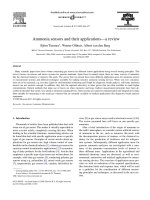CH26 detailed diagnostic and sensors STUDENT VERSION rev
Bạn đang xem bản rút gọn của tài liệu. Xem và tải ngay bản đầy đủ của tài liệu tại đây (955.46 KB, 45 trang )
Chapter 26
Detailed Diagnosis and Sensors
Symptom-Based Diagnosis
• Before diagnosing symptoms, ensure:
–
–
–
–
–
–
–
ECM and MIL are operating correctly
No stored DTCs
Scan data within normal ranges
Scan tool to OBD system communication
No TSBs for current symptom
All ECM/PCM grounds are correct
Vehicle modifications identified
Common Symptoms
• Hard start/Long crank hard start
– Cranks normally but does not start quickly
• No crank
– Starter does not turn engine over
• No start (engine cranks)
– Engine turns over but does not start even after
prolonged cranking
Common Symptoms (cont’d)
•
•
•
•
•
•
Lack of or loss of power
Cuts out, misses
Hesitation or stumble
Surges
Detonation/spark knock
Poor fuel economy
Testing Sensors
• All sensors detect a condition and change it
into an electrical signal.
• Sensors may be:
–
–
–
–
Switches
Variable resistors
Voltage or frequency generators
Some inputs are simply connections from other
modules or battery voltage and ground
Diagnosis of Computer
Voltage Supply and Ground Wires
• Verify the power and ground circuits to the
ECM/PCM.
• Check power and ground circuit voltage
drop.
• Good ground circuits is critical for all
reference voltage sensors.
Switches
•
•
•
•
Either normally open or normally closed.
Send digital signal to the PCM.
Some are provided with a reference voltage.
Can be on ground or power circuit.
Testing Switches
• With an ohmmeter
• With a voltmeter
• Some switches are adjustable
Temperature Sensors
• Most are NTC thermistors.
– High resistance cold
– Low resistance hot
• PCM supplies 5 volts reference.
• Voltage changed by sensor.
• Signal returns on the ground wire.
Testing
•
•
•
•
•
Scan tool values
Highest possible value = short in circuit
Lowest possible value = open in circuit
Place in water
Never apply an open flame to a sensor
Pressure Sensors
• Most are piezometric sensors.
• The amount of flex dictates the voltage
signal.
• One side exposed to reference pressure and
other to a calibrated pressure or vacuum.
MAP Sensors
• Sense air pressure in the intake manifold.
• Not significantly affected by altitude or
barometric pressure.
• Intake pressure varies based on engine
speed and load.
• Used to calculate fuel delivery.
Testing MAP Sensors
•
•
•
•
•
Can cause rich, lean, or surging conditions.
Check vacuum supply .
PCM supplies 5 volt reference and ground.
MAP can be monitored with scan tool.
Frequency output can be scoped.
Barometric Pressure (BARO)
Sensor
• Used on some engines to alter fuel and
ignition timing based on altitude.
• Higher elevations have less atmospheric
pressure.
• Often located in PCM and not separately
replaceable.
Vapor Pressure Sensor (VPS)
•
•
•
•
•
Measures vapor pressure in EVAP system.
Responds to slight changes.
May be mounted on fuel pump or remotely.
Remote sensors have hose connections.
Check hoses and connections.
Mass Airflow (MAF) Sensors
• Measures air entering the engine.
• Used to calculate engine load.
• Sensors are placed between air cleaner and
throttle plate.
• Common MAF sensors include - hot wire,
vane-type, and Karmen vortex type
Oxygen Sensors (O2S)
• Used to ensure correct air/fuel ratio for
catalytic converter.
• OBD II requires pre and post converter
sensors.
• Generate voltage based on oxygen content
in the exhaust.
• Lean = low voltage, rich = high voltage
Titanium Dioxide (TiO2) Sensors
• Do not generate voltage.
• Alters a 5 volt reference signal.
• Low oxygen content equals low voltage,
below 2.5 volts.
• High oxygen content equals voltage above
2.5 volts.
Air/Fuel Ratio (A/F) Sensors
• Changes current in the circuit.
• Can be used in very lean conditions.
• At stoichiometric, no current is generated
and the voltage detection circuit is 3.3 volts.
• When rich, there is negative current flow
and voltage is below 3.3 volts.
Checking O2 Sensors and Circuits
• Things that can cause an O2 sensor to appear
faulty:
–
–
–
–
–
–
Incorrect fuel pressure
Malfunctioning AIR system
EGR leak
Leaking injector
Vacuum leak
Contaminated MAF sensor









